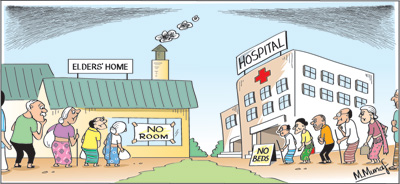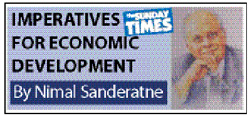Columns
From paediatrics to geriatrics caring for health needs
View(s):The rapidly rising ageing population is increasing the demand for healthcare for illnesses associated with longevity. The country’s public health system that has achieved much in the past is heavily geared to improving maternal and child health and fighting infectious diseases. There is now a need to shift the emphasis from paediatrics to geriatrics and to non communicable diseases associated with old age. Simultaneously, the ageing population and social changes are escalating the need for institutional care of the elderly. These are huge challenges in the context of inadequate fiscal space and human resources.
 Increasing NCDs
Increasing NCDs
The incidence of non communicable diseases (NCDs) such as heart disease, diabetes, cancers and asthma are becoming more frequent as the population ages, incomes rise, urbanization increases, diets become less healthy and lifestyles become more sedentary. The rise in obesity, smoking and alcoholism has also increased the risk of NCDs. The share of deaths from cardiovascular disease has increased from three percent to over 25 percent in the past five decades.
Geriatric services
Geriatric services that are quite inadequate at present should become a priority specialization. The incidence of old-age illnesses, like Alzheimer’s (a degenerative brain disease causing severe memory loss), arthritic conditions and osteoporosis (a degenerative bone disease) will increase considerably. The incidence of diabetes, heart conditions and cancer would also increase. Extended longevity of the population requires greater attention to such health conditions.
Healthcare ill-equipped
The current public healthcare system is ill-equipped to provide the long-term care associated with the treatment of NCDs. With those over 60 years expected to be around 50 per cent of the population by the middle of this century, health care systems require to be geared to illnesses associated with longevity and senile conditions.
 The cost of an effective health care system to deal with these illnesses is hugely expensive. Shortage of skilled medical professionals is another constraining factor. The increase in health expenditure in the 2016 budget must be accompanied by a higher investment on addressing the increasing illnesses of the rising ageing population.
The cost of an effective health care system to deal with these illnesses is hugely expensive. Shortage of skilled medical professionals is another constraining factor. The increase in health expenditure in the 2016 budget must be accompanied by a higher investment on addressing the increasing illnesses of the rising ageing population.
Care of elderly
The ageing of the country’s population also poses serious social challenges of caring for the elderly population. The ageing of the population implies the need to have methods of caring for the elderly.
Traditionally, Sri Lankan society has cared for the elderly through the extended family system. Even at present most of the elderly are cared for at the home of a family member, especially in rural areas. However this traditional system is breaking down.
Traditional system weakening
Increased female labour participation, erosion of incomes through inflation, increased consumer needs, pressures on housing conditions, migration of wives and daughters for overseas employment and changing social values have all contributed to the erosion of the traditional system of caring for the elderly within the household.
This erosion of the traditional system of caring for the elderly is likely to wear down rapidly in urban areas, owing to these factors. A very high proportion of the elderly in institutional homes have three or more children who were either abroad or unable to look after them in their homes. Many elderly persons had a preference for living in these institutions owing to the difficulties of coping with the modern life styles of their children and grand children.
The capacity of the traditional system to maintain the elderly is likely to be progressively weakened. Therefore there is a need to consciously find institutional and community-based systems of caring for the elderly.
Inadequate institutional care
At present, residential facilities for the elderly are run by the state, by voluntary organizations with some state assistance and by community-based or religious organizations without any state assistance. The long waiting lists for admission to these institutions are evidence of the demand for such facilities exceeding the available accommodation.
Day care services
Apart from residential accommodation, there are some recent efforts to provide day care services for the elderly. This is a far more cost-effective programme that also satisfies the psychological and sociological needs of the family more satisfactorily. Helpage Sri Lanka has been in the forefront of providing such services and has established a model Day Care Centre in Ratmalana. A replication of this service by local communities would indeed be a means of assisting the elderly.
Community facilities
Some villages too have organised to provide accommodation and food for the elderly in their village in the proximity to their relations and friends. These efforts in the right direction are however inadequate to meet the increasing demand for such services.
The government needs to strengthen these community based efforts by development of facilities and provision of financial assistance.
Private homes
The more-affluent aged in Sri Lanka could be cared for by the development of homes through private enterprise. Yet the supply of such facilities appears to lag behind demand even at present. The bulk of the elderly population, however, needs public support for their care. Such institutional systems would require both public funding and voluntary contributions, and may need to be organized by community and religious-based groups. Elders’ homes run by religious, charitable or community based organisations charge very moderate fees but the total capacity of these is very limited.
The difficulties in expanding institutional capacities to care for the elderly are not confined to financial constraints. It requires new modes of thinking, dedicated trained personnel and the mobilization of human resources through voluntary and community participation.
Concluding reflections
The rapid ageing of the country’s population poses serious economic, health and social challenges. The emerging health problems associated with an ageing population and care of the elderly necessitate higher social expenditures, health and social welfare reforms and the building of institutional capacities. The poor state of public finances would require to be corrected to address these issues.


Leave a Reply
Post Comment